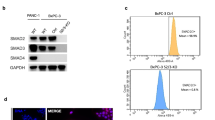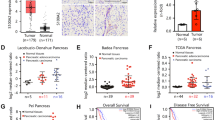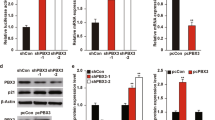Abstract
The transforming growth factor-β (TGF-β)–Smad signaling pathway inhibits the growth of human epithelial cells and plays a role in tumor suppression. The Smad4 gene is mutated or deleted in 50% of pancreatic cancers. In this study, the Smad4-null pancreatic cancer cell line BxPC-3 was transfected with either the Smad4 expression vector or the empty vector and incubated in the presence or absence of TGF-β. The cells were analysed using a cDNA microarray, which included 2280 named genes to screen for target genes regulated by TGF-β in either a Smad4-dependent or -independent manner. The microarray and subsequent quantitative RT–PCR analysis demonstrated that the Smad4-independent and -dependent signaling pathways driven by TGF-β upregulated only one of the 2280 genes, respectively, suggesting that Smad4-independent signaling downstream of TGF-β might be as widespread as Smad4-dependent signaling. In this study, we demonstrated that the cyclin-dependent kinase inhibitor p21/WAF1, which has been considered the major effector of the Smad-dependent growth inhibitory signal of TGF-β, is upregulated in a Smad4-independent manner. The upregulation occurs through Smad2/3-dependent transcriptional activation of the p21/WAF1 promoter region. These results suggest a novel mechanism of gene regulation, that is, a novel signal mediator other than Smad4.
This is a preview of subscription content, access via your institution
Access options
Subscribe to this journal
Receive 50 print issues and online access
$259.00 per year
only $5.18 per issue
Buy this article
- Purchase on Springer Link
- Instant access to full article PDF
Prices may be subject to local taxes which are calculated during checkout








Similar content being viewed by others
References
Akiyoshi S, Ishii M, Nemoto N, Kawabata M, Aburatani H and Miyazono K . (2001). Jpn. J. Cancer Res., 92, 257–268.
Bhowmick NA, Ghiassi M, Bakin A, Aakre M, Lundquist CA, Engel ME, Arteaga CL and Moses HL . (2001). Mol. Biol. Cell, 12, 27–36.
Boukamp P, Petrussevska RT, Breitkreutz D, Hornung J, Markham A and Fusenig NE . (1988). J. Cell. Biol., 106, 761–771.
Callahan JF, Burgess JL, Fornwald JA, Gaster LM, Harling JD, Harrington FP, Heer J, Kwon C, Lehr R, Mathur A, Olson BA, Weinstock J and Laping NJ . (2002). J. Med. Chem., 45, 999–1001.
Cui W, Fowlis DJ, Bryson S, Duffie E, Ireland H, Balmain A and Akhurst RJ . (1996). Cell, 86, 531–542.
Dai JL, Schutte M, Bansal RK, Wilentz RE, Sugar AY and Kern SE . (1999). Mol. Carcinogen., 26, 37–43.
Datto MB, Yu Y and Wang X-F . (1995). J. Biol. Chem., 270, 28623–28628.
Derynck R, Akhurst RJ and Balmain A . (2001). Nat. Genet., 29, 117–129.
Derynck R, Goeddel DV, Ullrich A, Gutterman JU, Williams RD, Bringman TS and Berger WH . (1983). Cancer Res., 47, 707–712.
Engel ME, McDonnell MA, Law BK and Moses HL . (1999). J. Biol. Chem., 274, 37413–37420.
Eppert K, Scherer SW, Ozcelik H, Pirone R, Hoodless P, Kim H, Tsui LC, Bapat B, Gallinger S, Andrulis IL, Thomsen GH, Wrana JL and Attisano L . (1996). Cell, 86, 543–552.
Friess H, Yamanaka Y, Buchler M, Ebert M, Beger HG, Gold LI and Korc M . (1993). Gastroenterology, 105, 1846–1856.
Giehl K, Seidel B, Gierschik P, Adler G and Menke A . (2000). Oncogene, 19, 4531–4541.
Grady WM, Myeroff LL, Swinler SE, Rajput A, Thiagalingam S, Lutterbaugh JD, Neumann A, Chang J, Kim S-J, Kinzler KW and Vogelstein B . (1999). Cancer Res., 59, 320–324.
Grau AM, Zhang L, Wang W, Ruan S, Evans DB, Abbruzzese JL, Zhang W and Chiao PJ . (1997). Cancer Res., 57, 3929–3934.
Hahn SA, Schutte M, Hoque ATMS, Moskaluk CA, da Costa LT, Rozenblum E, Weinstein CL, Fischer A, Yeo CJ, Hruban RH and Kern SE . (1996). Science, 271, 350–353.
Hartsough MT and Mulder KM . (1995). J. Biol. Chem., 270, 7117–7124.
Hocevar BA, Brown TL and Howe PH . (1999). EMBO J., 18, 1345–1356.
Hu PP, Shen X, Huang D, Liu Y, Counter C and Wang XF . (1999). J. Biol. Chem., 270, 35381–35387.
Ijichi H, Ikenoue T, Kato N, Mitsuno M, Togo G, Kato J, Kanai F, Shiratori Y and Omata M . (2001). Biochem. Biophys. Res. Commun., 289, 350–357.
Inman GJ, Nicolas FJ, Callahan JF, Harling JD, Gaster LM, Reith AD, Laping NJ and Hill CS . (2002). Mol. Pharmacol., 62, 65–74.
Kawabata M, Inoue H, Hanyu A, Imamura T and Miyazono K . (1998). EMBO J., 17, 4056–4065.
Lukas J, Herzinger T, Hansen K, Moroni MC, Resnitzky D, Helin K, Reed SI and Bartek J . (1997). Genes Dev., 11, 1479–1492.
Markowitz S, Wang J, Myeroff L, Parsons R, Sun L, Lutterbaugh J, Fan RS, Zborowska E, Kinzler W, Vogelstein B, Brattain M and Willson JKV . (1995). Science, 268, 1336–1338.
Miyaki M, Iijima T, Konishi M, Sakai K, Ishii A, Yasuno M, Hishima T, Koike M, Shitara N, Iwama T, Utsunomiya J, Kuroki T and Mori T . (1999). Oncogene, 18, 3098–3103.
Miyazono K, ten Dijke P and Heldin CH . (2000). Adv. Immunol., 75, 115–157.
Moustakas A and Kardassis D . (1998). Proc. Natl. Acad. Sci. USA, 95, 6733–6738.
Oft M, Heider KH and Beug H . (1998). Curr. Biol., 8, 1243–1252.
Otsuka M, Kato N, Lan KH, Yoshida H, Kato J, Goto T, Shiratori Y and Omata M . (2000). J. Biol. Chem., 275, 34122–34130.
Otsuka M, Kato M, Yoshikawa T, Chen H, Brown EJ, Masuho Y, Omata M and Seki N . (2001). Biochem. Biophys. Res. Commun., 289, 876–881.
Pardali K, Kurisaki A, Moren A, ten Dijke P, Kardassis D and Moustakas A . (2000). J. Biol. Chem., 275, 29244–29256.
Schutte M, Hruban RH, Hedrick L, Cho KR, Nadasdy GM, Weinstein CL, Bova GS, Isaacs WB, Cairns P, Nawroz H, Sidransky D, Casero Jr RA, Meltzer PS, Hahn SA and Kern SE . (1996). Cancer Res., 56, 2527–2530.
Simeone DM, Pham T and Logsdon CD . (2000). Ann. Surg., 232, 73–80.
Togo G, Toda N, Kanai F, Kato N, Shiratori Y, Kishi K, Imazeki F, Makuuchi M and Omata M . (1996). Cancer Res., 56, 5620–5623.
Villanueva A, Garcia C, Paules AB, Vicente M, Megias M, Reyes G, de Villalonga P, Agell N, Lluis F, Bachs O and Capella G . (1998). Oncogene, 17, 1969–1978.
Wang D, Kanuma T, Mizunuma H, Takama F, Ibuki Y, Wake N, Mogi A, Shitara Y and Takenoshita S . (2000). Cancer Res., 60, 4507–4512.
Wrana JL, Attisano L, Carcamo J, Zentella A, Doody J, Laiho M, Wang XF and Massague J . (1992). Cell, 71, 1003–1014.
Yu L, Hebert C and Zhang YE . (2002). EMBO J., 21, 3749–3759.
Zavadil J, Bitzer M, Liang D, Yang YC, Massimi A, Kneitz S, Piek E and Boettinger EP . (2001). Proc. Nat. Acad. Sci. USA, 98, 6686–6691.
Acknowledgements
We thank R Derynck, J Wrana, X-F Wang, J Massague, R Booher, and NE Fusenig for providing plasmids and cell lines, and Y Hikiba and M Tsubouchi for technical assistance.
Author information
Authors and Affiliations
Corresponding author
Rights and permissions
About this article
Cite this article
Ijichi, H., Otsuka, M., Tateishi, K. et al. Smad4-independent regulation of p21/WAF1 by transforming growth factor-β. Oncogene 23, 1043–1051 (2004). https://doi.org/10.1038/sj.onc.1207222
Received:
Revised:
Accepted:
Published:
Issue Date:
DOI: https://doi.org/10.1038/sj.onc.1207222
Keywords
This article is cited by
-
SMAD4 endows TGF-β1-induced highly invasive tumor cells with ferroptosis vulnerability in pancreatic cancer
Acta Pharmacologica Sinica (2024)
-
Chimeric TβRII-SE/Fc overexpression by a lentiviral vector exerts strong antitumoral activity on colorectal cancer-derived cell lines in vitro and on xenografts
Cancer Gene Therapy (2024)
-
Tumor-associated macrophages promote PD-L1 expression in tumor cells by regulating PKM2 nuclear translocation in pancreatic ductal adenocarcinoma
Oncogene (2022)
-
SMAD2/3 mediate oncogenic effects of TGF-β in the absence of SMAD4
Communications Biology (2022)
-
MicroRNA-183-5p: A New Potential Marker for Prostate Cancer
Indian Journal of Clinical Biochemistry (2019)



